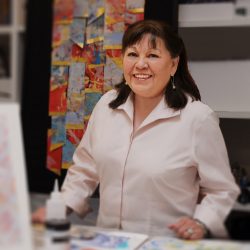“Today the world belongs to the peoples of all nations…and to this world each one of us is responsible.”
– Hamilton Warren, Founder, Verde Valley School, Sedona, AZ
I was born and raised in the American Southwest. My upbringing and my view of the world, I realize now, were different from those of women who grew up in other places. I knew women who had families, owned businesses, raised livestock and managed ranches, and flew their own planes. I grew up believing everything was possible.
Early on, I was interested in art. Art is the vocabulary of the soul and the one thing we most remember when we stitch together the fabric of the great civilizations of the past. My own artwork has led me to arts administration, partnerships with arts organizations, and work in the architectural field, where culture and aesthetics merge.
Art bridges age, gender, ethnicity, and economics. It is a vehicle that brings communities of all sizes together. It is an individual idea and a collective dialogue. Art is a necessity, not a luxury.
I have a deep understanding and appreciation of Native American cultural values, arts, and community. As an artist, arts administrator, and art advocate I bring a unique approach for developing funding strategies and partnerships to Native America.
My professional focus for the last thirteen years has been on seamlessly designing culturally meaningful artwork into the environment—both natural and architectural. The art becomes part of the place, and it is a fundamental component of the project form the very beginning of the design process.
Using collaborative working methods, I am able to distill and synthesize design vocabularies into working documents for landscape architects, architects, exhibit designers, educators, and clients. I often begin by experiencing a space, noting plants, animals, birds, humans, traffic, weather, geology, agriculture, and water. I conduct personal interviews with stakeholders, users, and others who have an interest in the project. I have developed a Cultural Values document that I use in these conversations. I interview a project’s detractors as well as its proponents, which can help unify the community.
In the beginning of a project, I am the human sponge, absorbing and ingesting information, photographs, stories, maps, textures, dreams, important ideas, desires, colors, attributes, and nuances. Synthesized, these become my working palette. I blend what I’ve learned together and present concepts to my team to be reworked and defined.

